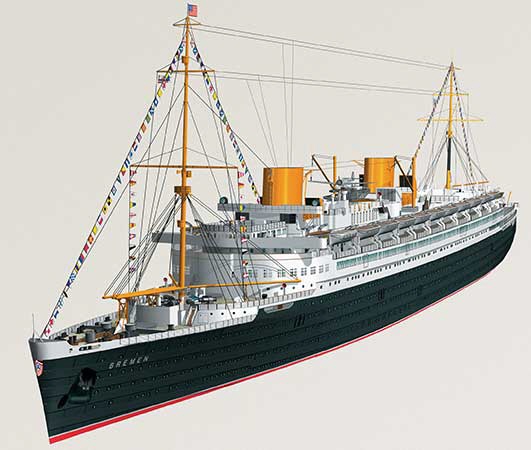Ocean Liner “Bremen” IV

Publishing house: Hamburger Modellbaubogen Verlag
Scale: 1:250
Length: 115 cm (45.28 inch)
Width: 12 cm (4.72 inch)
Height: 25 cm (9.84 inch)
Degree of difficulty: 3 (very difficult)
Number of sheets: 23
Parts: 1915 (including optional parts: 4982)
In addition, two laser-cut sets are also available (order no. 4302 Details & Railings + 4303 Interior).
This model is definitely something special. It includes the interior of the bridge, the dining hall of the 1st class, and the smoker room. It also includes a catapult and an airplane for mail delivery.
The model of the ocean liner Bremen IV is a favourite for many model builders. The intriguing story behind this beautiful ship both in regards of history and design reflects itself adequately in the outstanding design of this enormous model with over a meter in length.
But the real challenge and pleasure with this master piece from Peter Brandt can be found in all the possible details that can be built. Of course there is the almost unbelievable jumble of exhausts on the top deck which Peter designed correctly and true to the original. This already asks for some patience from the modeller. But during the building you also have the possibility to build the interior of the bridge, the dining hall of the first class and the smoking room. As if this is not enough the kit offers all flags necessary to build Bremen “dressed overall”. The necessary flags for all dressing lines are included in the model kit.
The model highlights:
• including catapult and airplane
• including interior of the bridge
• the interior of the dining hall 1st class can be built
• two grand pianos and matching chairs
• more than 1,000 chairs and tables
• deck chairs
• international code of signals
• 28 life boats
• two different versions of the funnels
• and much more
Ocean Liner “Bremen” IV
Once the German shipping company NDL recovered after the First World War and the company development was assesed as positive the idea to build new ships in order to compete with other shipping companies again. In 1926 after some debates a decision was made in favour of a so called “5 day ship”. A ship that could leave Southampton or Cherbourg at a favourable time of the day for passengers and still arrive in New York at a time that would allow going through customs within 5 days. The plan was to establish a weekly service with two new ships and the existing Columbus.
The contract for the new Bremen went to AG Weser and for the new Europa it went to Blohm & Voss. Both ships were built with various novelties like for example the bulbous bow that was copied from American ships and interestingly was realised in very different ways for the two ships. Bremen and Europa were state-of-the-art both in questions of design and of luxury facilities. The achievements by German shipbuilders and German interior architects was back then acknowledged worldwide. And with the legendary service of NDL both ships were a great success. On July 5th in 1929 the NDL took over the Bremen from the shipyard. The first voyage to New York started on the 16th that month. The maiden voyage of Bremen was a big media event. With a cruising speed of 27.83 knots Bremen topped the record speed of Mauretania in 1909 (26.06 knots) and won the legendary Blue Ribbon.
Both ships were camouflaged for the operation Sea Lion and received an extensive paint job. Operation Sea Lion did not happen but the camouflage job was done. On the 6th of March in 1941 Bremen caught fire. All attempts to fight the fire failed – Bremen completely burnt down in the harbour of Bremen and was finally scrapped.
Technical data:
• launch: 16/08/1928 at AG Weser, Bremen
• commissioning: 05/07/1929
• length: 286.10 m
• width: 31 m
• displacement: 51,860 BRT
• engine: turbines
• top speed: 27 knots
• owner: Norddeutscher Lloyd Bremen (NDL)
• sister ship: Europa
• crew: 1,000 Mann
• 1st class: 800 passengers
• 2nd class: 500 passengers
• tourist class: 300 passengers
• 3rd class: 600 passengers
• route: Bremerhaven - New York
